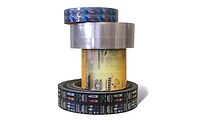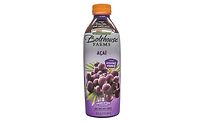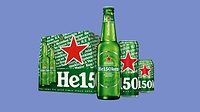Packaging Materials
Labeling materials prompt purchasing behavior
ACTEGA releases new premium label decorating solution

The idiom “it takes two to tango” doesn’t literally suggest that two people are dancing. Yet, this commonly heard expression suggests that one or more entities are inextricably linked. In the case of aluminum cans, plastic bottles or glass packaging, the application of premium labels and how they look and feel on a product are intertwined and play a pivotal role in prompting purchasing behavior.
“The drive toward premium beverages has corresponded to use of more premium labeling materials such as film and specialty papers as well as embellishments and using various inks and coatings to convey the premium nature of the product through the packaging,” says Gwen Chapdelaine, marketing director at Fort Dearborn Co., Elk Grove Village, Ill.
“There are a variety of film and paper materials available for beverage labeling depending upon the type of label being used. For beverages, wet strength papers as well as film labels are popular due to their ability to withstand cold, wet environments such as ice coolers,” she continues. “These materials have evolved over the years including the development of recyclable paper and film options for PET containers which are a popular container choice for beverages.”
To appeal to busy consumers scanning store shelves, beverage-makers should spend money on design, advises Justin Slarks, director of marketing at Little Rock, Ark.-based Sleeve Seal. “Everyone has the same canvas and pallet available to them, but only good designers can make the magic happen. Shelf appeal is everything in today’s competitive marketplace,” he explains. “Premium beverage brands are creating and applying some very appealing labels for their premium products. They know that there is competition on the shelves, and they are decorating with enticing, boutique labels for their products. Beverages that retail for $4 per can are now available so the labels need to do the selling on the shelves.”

Image courtesy of Sleeve Seal
Chapdelaine also notes that the changes in primary packaging have impacted the type of label used. “Changes toward more contoured containers as well as lightweight structures have an effect on which types of labels can be used for a particular application,” she explains. “Contoured containers are more suitable for film-based labels such as shrink sleeves, stretch sleeve or roll-fed shrink.”
A hot-button topic
Although design and shelf appeal are important, the impact of sustainability on the container and its labeling materials remains a hot-button topic, particularly as Canada has recently enforced a nationwide ban on many single-use plastics.
Similarly, a number of single-use plastics are being banned across the European Union, with plastic bottles in particular targeted with a collection rate of 77% by 2025 and 90% by 2029, notes Anthony Carignano, technical director of marketing for Signite, ACTEGA at ACTEGA North America Technologies Inc., East Providence, R.I.
“The pressure to rethink and reduce the use of plastic has never been greater,” Carignano notes. “All of these moves, designed to encourage the beverage industry to reduce the amount of plastic used as well as recycle and reuse beverage containers, is creating a demand for labels that use less plastic and/or are easy to remove from the container.”
Canada’s goal is to achieve zero plastic waste by 2030, which will affect the usage of shrink sleeves and conventional pressure sensitive labeling techniques, he adds. In California, there’s legislation — AB 962 — that’s focused on creating a returnable bottle system to aid in recycling.
“If passed, AB 962 Legislation would create a returnable bottle system in California and preserve bottles so that they can be washed and refilled by beverage producers rather than being crushed for recycling,” he explains. “It would also allow for returnable bottles to flow through the state's Beverage Container Recycling Program (CRV/Bottle Bill). This bill would even the playing field between bottle washers and recyclers by paying the same amount.”

Image courtesy of ACTEGA
With sustainability and protecting natural resources top of mind, in June, ACTEGA launched the patented Signite, a revolutionary, premium quality label decorating solution designed to reduce label waste. Depending on the decoration design, the technology can currently reduce label waste by more than 50% compared with a similar footprint pressure-sensitive label, Carigno says. Additionally, the “no label look” label reduces the decoration thickness to about a third of that of a typical clear pressure-sensitive label and eliminates label media plastic in non-print areas, he adds.
A multinational manufacturer and distributor of pressure-sensitive adhesive materials and labels, Avery Dennison, Glendale, Calif., announced its goal to be net-zero on greenhouse gas emissions by 2050. This commitment comes as the company raises the bar on its sustainability goals with new targets for 2030, the company said in a statement.
As part of its new targets, the Label and Graphic Materials (LGM) business commits to 100% of its core film and paper product categories globally containing recycled or renewable content. All of its regions also will have labels that enable the circularity of plastics, ensuring the company will be “well-positioned to satisfy current or future recycling, composting or reuse requirements for single-use consumer plastic packaging,” it said. Additionally, Avery Dennison is expanding its portfolio to include more intelligent labeling to advance the communication of data, reduce costs and waste, and create better recycling processes.
Fort Dearborn’s Chapdelaine notes that sustainability trends have translated into thinner materials (downgauging) as bottles have been lightweighted. “Materials that use PCR / PCW (post-consumer recycled waste) content and developments with material to support recycling efforts such as recyclable and floatable labels are being used,” Chapdelaine says. “As CPGs and retailers have and continue to launch goals to make their packaging recyclable, compostable, biodegradable and increasing the use of recycled materials, related developments in sustainable labeling materials will continue in support of these efforts. At Fort Dearborn Co., we offer beverage brands a variety of sustainable label options for their products.”
The company offers a variety of paper and film substrates as well as design and finishing effects for each label technology, including cut and stack, pressure sensitive, roll-fed, shrink sleeve and stretch sleeve. Among the specialty inks and coatings it offers are glow-in-the-dark, metallic, pearlescent and matte, soft touch, tactile and UV coatings.
At 40 million tons, polyvinyl chloride (PVC) is the world’s third-most widely produced synthetic plastic polymer. Yet, PET is more popular because it is a recyclable material with great shrink characteristics, Sleeve Seal’s Slarks says.
“Since the early days of shrink labels, film substrates continue to be thinner, clearer, cheaper and easier to recycle, so a lot has changed,” he notes. “…The recent shortage of aluminum cans, combined with the new brands rushing to ride the surge in consumption, has created a wave of shrink labeled cans that are amazing. New tactile ink technologies are being incorporated by smart designers to create unique looks and that look and ‘feel’ amazing.”

Image courtesy of Avery Dennison
Smart labeling on the rise
As labeling solutions enable increased sustainability and recyclability of end products and brands continue to buy in to this core focus, environmentally conscious brands, consumers and manufacturers will lead the way with solutions that meet or exceed these requirements, Signite ACTEGA’s Carignano says.
He notes that “smart labeling,” which initially was used to describe packaging technology that utilized radio-frequency identification (RFID) and near field communication to transmit information, will become more prevalent, particularly as eCommerce platforms and fulfillment increase and prices for the technology decrease.
“Today, smart labeling is quickly becoming a way for beverage brands to enable product tracking and brand engagement. Brand protection and anti-counterfeiting are also significant areas of applications for intelligent labels. The basis of smart label technology is in covert optical codes (i.e., digital watermarking), color fluorescence, or taggants' insertion that can only be detected at a forensic level,” Carignano explains. “Although pharmaceuticals and spirits are the biggest markets for this technology today, various smart label technologies are dropping in price quickly enough to enhance and enable recyclability and reuse streams for beverage containers in the near future.”
Design wise, he notes that the “no label look” is increasingly popular for brands looking to create a unique aesthetic that stands out on the shelf. The printing on slightly reconfigured narrow web flexo or hybrid digital printing processes are enabling small- to mid-sized brands to put the technology to work on new or modified variations of their printing assets.
“Adding relief effects or soft touch surfaces to shrink sleeves is also a great way to provide brands with an impactful and engaging marketing opportunity,” Carignano says. “We believe that our Signite decorating process, which can be printed either via 100% Flexo or hybrid piezo inkjet digitally enables significant design flexibility when compared to screen printing or direct to object printing.”
High-speed Signite applicator machines and corresponding decoration media are in the works, with plans to move into prototyping in 2022, he adds. Signite is creating its own product category, according to Carignano.
“Signite decoration combines all attributes of high-performance coatings, inks, and adhesives printed and then transferred to beverage containers like a no-look pressure sensitive label, but with the vibrant appearance of a direct-to-object printed surface,” he explains. “… Signite represents the beginning of a new and much more sustainable beverage labeling as environmental concerns about petroleum-based labeling are being met by material innovation in the beverage label space.”
Looking for a reprint of this article?
From high-res PDFs to custom plaques, order your copy today!







